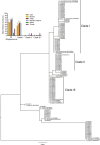Characterization and comparison of bacterial communities in benign vocal fold lesions
- PMID: 25671105
- PMCID: PMC4323261
- DOI: 10.1186/2049-2618-2-43
Characterization and comparison of bacterial communities in benign vocal fold lesions
Abstract
Background: Benign vocal fold lesions, including cysts, nodules, polyps, and Reinke's edema, are common causes of hoarseness and subsequent voice disorders. Given the prevalence of these lesions, disease etiology and pathophysiology remain unclear and their microbiota has not been studied to date secondary to the paucity of available biopsies for investigation. We sought to characterize and compare the bacterial communities in biopsies of cysts, nodules, polyps, and Reinke's edema collected from patients in Germany and Wisconsin. These samples were then compared to the communities found in healthy saliva and throat samples from the Human Microbiome Project (HMP).
Results: 454 pyrosequencing of the V3-V5 regions of the 16S rRNA gene revealed five phyla that explained most of the bacterial diversity, including Firmicutes (73.8%), Proteobacteria (12.7%), Bacteroidetes (9.2%), Actinobacteria (2.1%), and Fusobacteria (1.9%). Every lesion sample, regardless of diagnosis, had operational taxonomic units (OTUs) identified as Streptococcus, with a mean abundance of 68.7%. Most of the lesions, 31 out of 44, were indistinguishable in a principal coordinates analysis (PCoA) due to dominance by OTUs phylogenetically similar to Streptococcus pseudopneumoniae. Thirteen lesions not dominated by S. pseudopneumoniae were more similar to HMP throat and saliva samples, though 12 of them contained Pseudomonas, which was not present in any of the HMP samples. Community structure and abundance could not be correlated with lesion diagnosis or any other documented patient factor, including age, sex, or country of origin.
Conclusions: Dominance by S. pseudopneumoniae could be a factor in disease etiology, as could the presence of Pseudomonas in some samples. Likewise, decreased diversity, as compared to healthy saliva and throat samples, may be associated with disease, similar to disease models in other mucosal sites.
Keywords: Benign lesions; Larynx; Microbiota; Streptococcus; Voice disorders.
Figures




Similar articles
-
Signs and symptoms to determine if a patient presenting in primary care or hospital outpatient settings has COVID-19.Cochrane Database Syst Rev. 2022 May 20;5(5):CD013665. doi: 10.1002/14651858.CD013665.pub3. Cochrane Database Syst Rev. 2022. PMID: 35593186 Free PMC article.
-
The effect of sample site and collection procedure on identification of SARS-CoV-2 infection.Cochrane Database Syst Rev. 2024 Dec 16;12(12):CD014780. doi: 10.1002/14651858.CD014780. Cochrane Database Syst Rev. 2024. PMID: 39679851 Free PMC article.
-
Sexual Harassment and Prevention Training.2024 Mar 29. In: StatPearls [Internet]. Treasure Island (FL): StatPearls Publishing; 2025 Jan–. 2024 Mar 29. In: StatPearls [Internet]. Treasure Island (FL): StatPearls Publishing; 2025 Jan–. PMID: 36508513 Free Books & Documents.
-
Behavioral interventions to reduce risk for sexual transmission of HIV among men who have sex with men.Cochrane Database Syst Rev. 2008 Jul 16;(3):CD001230. doi: 10.1002/14651858.CD001230.pub2. Cochrane Database Syst Rev. 2008. PMID: 18646068
-
[Volume and health outcomes: evidence from systematic reviews and from evaluation of Italian hospital data].Epidemiol Prev. 2013 Mar-Jun;37(2-3 Suppl 2):1-100. Epidemiol Prev. 2013. PMID: 23851286 Italian.
Cited by
-
Toward an Understanding of the Pathophysiology of Chronic Laryngitis.Perspect ASHA Spec Interest Groups. 2016 Mar;1(3):14-25. doi: 10.1044/persp1.sig3.14. Epub 2016 Mar 1. Perspect ASHA Spec Interest Groups. 2016. PMID: 32864454 Free PMC article.
-
Microbiome and Communication Disorders: A Tutorial for Clinicians.J Speech Lang Hear Res. 2025 Jan 2;68(1):148-163. doi: 10.1044/2024_JSLHR-24-00436. Epub 2024 Nov 21. J Speech Lang Hear Res. 2025. PMID: 39572259 Free PMC article. Review.
-
Alterations of bacterial communities of vocal cord mucous membrane increases the risk for glottic laryngeal squamous cell carcinoma.J Cancer. 2021 May 13;12(13):4049-4063. doi: 10.7150/jca.54221. eCollection 2021. J Cancer. 2021. PMID: 34093809 Free PMC article.
-
Spatial Variation of the Gut Microbiota in Broiler Chickens as Affected by Dietary Available Phosphorus and Assessed by T-RFLP Analysis and 454 Pyrosequencing.PLoS One. 2015 Nov 20;10(11):e0143442. doi: 10.1371/journal.pone.0143442. eCollection 2015. PLoS One. 2015. PMID: 26588075 Free PMC article.
-
A comparison of sampling methods for examining the laryngeal microbiome.PLoS One. 2017 Mar 31;12(3):e0174765. doi: 10.1371/journal.pone.0174765. eCollection 2017. PLoS One. 2017. PMID: 28362810 Free PMC article.
References
-
- Jacobson BH, Johnson A, Grywalski C, Silbergleit A, Jacobson G, Benninger MS, Newman CW. The voice handicap index (VHI): development and validation. Am J Speech Lang Pathol. 1997;6:66–70. doi: 10.1044/1058-0360.0603.66. - DOI
Grants and funding
LinkOut - more resources
Full Text Sources
Other Literature Sources

